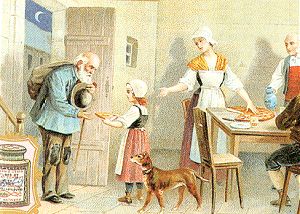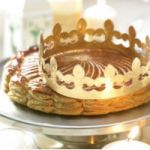
January 6th - Epiphany is a festival that dates back almost 2000 years, celebrated in every Catholic country and community. With it the Christmas season reaches its peak with a commemoration of the arrival of the three kings with gifts for the newborn baby Jesus. There were Gaspar, Balthazar and Melchior, three continents, three presents: gold, frankincense and myrrh. In many villages, "kings'fires" are still lit as a reminder of the fires that, according to legend, burned that night in Bethlehem to hide the star from King Herod.
The bean that is placed in the traditional Epiphany galette, or king's cake, is a tradition dating back to Roman times. A black or white bean was used for voting in elections, and during the Roman feast of Saturnalia in early January, the king of the festival was also chosen by means of a bean. Though the tradition had religious origins, it has become a family tradition during which everyone gathers together to cut the famous galette. Whoever finds the bean will be crowned king… and will choose his queen. In the old days in England, as well as in Burgundy, a couple was chosen at random by placing both a bean and a pea into the cake.

The first portion is always the "poor man's share," the "share of God and the Virgin," and was marked out by the youngest child of the family. There were also portions for those who were absent - the son in the army, the relative aboard one of the king's ships, the fisherman who had been unable to return. The portion was stored in the hutch until they came back, a way of saying "We were thinking about you." If it kept for a long time without crumbling or moulding, it was seen as a good omen.
The three kings' cake or galette, made from puff pastry in which a bean is hidden, is a staple of classical French cuisine. In Quebec, the custom has been taken up enthusiastically. In Franche-Comté, the children would dress up as the three kings and wear a golden belt over a shirt decorated with stars. They would go from door to door singing and ringing bells to demand their share. Girls of marriageable age never missed saying a prayer in the evening: May I see in my sleeping The man I will marry in my waking. In lower Brittany, a poor man leading a horse decorated with boxwood and laurel would stop at each house to collect the share for the poor. In Franche-Comté they make a "galette de goumeau" (goumeau being a topping of choux pastry enriched with cream), that can weigh up to 150 kg! Made from rich brioche dough, it can be found in every bakery in Besançon as well as in the Doubs region.
England
Epiphany, or "Twelfth Night" as it is traditionally known in England, was marked by celebrations that brought an end to the twelve day Christmas period, and was the last chance for merry-making before returning to work. The Yule log, lit on Christmas day, remained burning until Twelfth Night in order to bring good fortune to the house for the coming year. Its charred remains were kept, both to kindle the next year's Yule log, as well as to protect the house from fire and lightning. The period leading up to Twelfth Night was celebrated in medieval times as the "festival of fools," during which a "lord of misrule" presided over mischief and wild antics. Twelfth Night itself was a traditional day for plays or "mummings," and it is thought that Shakespeare's play took its name from the fact that it was first performed as part of Twelfth Night celebrations about 1601.
Spain
The day of the three kings is an opportunity to exchange Christmas gifts, since originally it was the day, twelve days after the birth of Jesus, that the kings arrived bearing gifts for the child. The evening before, there is a parade of carriages through the streets and candied fruits and other sweets, a little foretaste of the next day, are tossed out. For this occasion, a crown-shaped loaf of bread is prepared, flavoured with orange and lemon zest, brandy and orange flower water, decorated with candied fruit and flaked almonds. A silver coin, a porcelain figure or a dry bean are hidden inside.
Guadeloupe
The celebrations here have a different feel from elsewhere in the world. Epiphany doesn't mean the last day of Christmas celebrations, but rather the first day of "kannaval" which lasts until the evening before Ash Wednesday. Lent brings an end to the wild celebrations during which the streets are filled with devils and demons dressed solely in black and white. The evening sees the carnival end with the "grand brilé Vaval," the burning of Vaval, the king of the carnival, amidst the cries and wails of the crowd.
Mexico
Preparations for Epiphany begin ten days before Christmas with the posadas. Just as the three kings were guided by the shepherds' star, each family joins in a procession bringing sweets to the village square. They will be used to fill piñatas, enormous brightly-coloured pottery or papier mâché animals to be hung up on the day of Epiphany. The children have to try to break the piñata so that it bursts open like a horn of plenty, showering them with candies and small coins.
Germany - The Butter Laws
In the 17th century, German bakers sent a petition to the pope asking that the ban on the use of butter in Christmas breads and pastries be abolished. In France in 1713 a parliamentary order prohibited the use of eggs, even for glazing bread. And when the Revolution occurred in 1789, the "festival of the kings" fell like a guillotine blade - no more crowns! Instead they drew lots for the bean to choose the "citizen" who would present the galette. But the old customs were too well-loved to die out. While in some countries Epiphany marks the crowning of the king or queen of the feast, the custom has an unhappier ending in this part of the world! Whoever discovers a little sugar Jesus or a bean in his "rosca de reyes," or king's crown, has to organize and pay for the Candlemas party on February 2, when all the guests will be invited for tamales. It is whispered that anyone who is a bit stingy won't hesitate to swallow the bean, but since the party takes place with family and friends, the subterfuge is quickly pointed out with laughs and good-natured taunts.

Galette de goumeau
A chou pastry enriched with cream.
Three kings cake
Puff pastry garnished with almond paste
Pithiviers fondant original
Glazed with fondant
Puff Pithiviers
Garnished with almond cream
Rum-raisin three kings cake
Puff pastry garnished with crème pâtissière flavoured with rum
Walnut twist, French Epiphany cake
Garnished with crushed nuts and dusted with icing sugar
On trouve également des coutumes similaires selon les pays et les régions :
Three kings cake, Bordeaux style
With candied angelica and crystalized or candy sugar
le tortell en Catalogne,
Roscón de Reyes in Spain
Bread loaf in the shape of a crown flavoured with lemon and orange zest, brandy and orange flower water
Bolo rei in Portugal
Bread crown with candied fruits, dry fruits and nuts macerated in port

-

 Recipes
Recipes
-

 Products
Products
-

 Entertaining
Entertaining
-

 Chefs
Chefs
-

 Hints & Tips
Hints & Tips
-

 Glossaries
Glossaries









